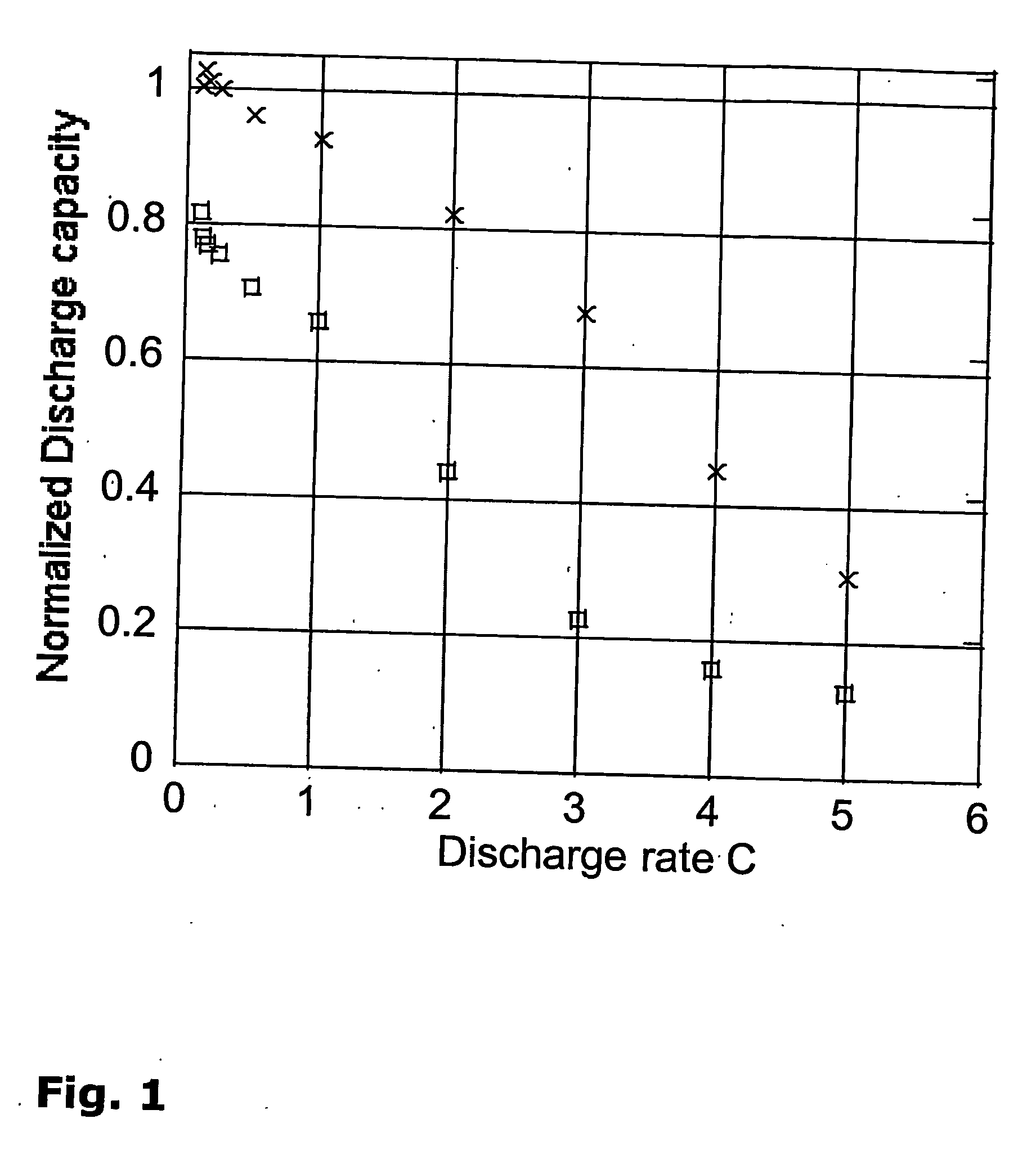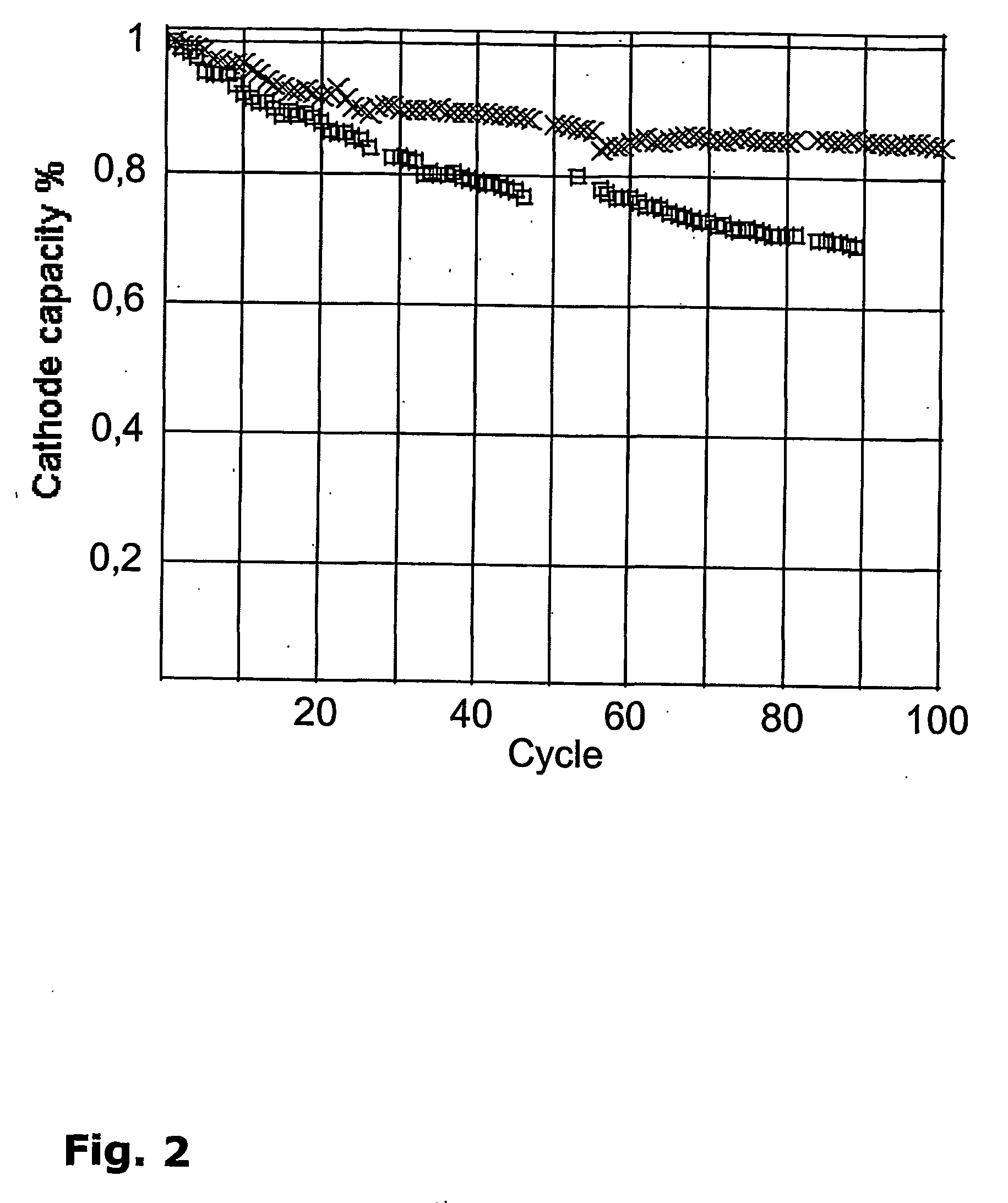Polymeric Binder for Fused Salts Electrolytes Based Batteries
a technology of fused salts and polymer binder, which is applied in the direction of non-aqueous electrolyte cells, cell components, non-metal conductors, etc., can solve the problems of limitation in the use of pvdf based polymers
- Summary
- Abstract
- Description
- Claims
- Application Information
AI Technical Summary
Benefits of technology
Problems solved by technology
Method used
Image
Examples
example 1
[0134]Film of PVDF-HFP copolymer Poly(vinylidene fluoride-co-hexafluoropropylene), produced by Solvay (Solef® 20810 / 1001) and a film of Poly(tetrafluoroethylene-co-vinylidene fluoride-co-polypropylene), named PVDF-TFE-PP, obtained from Aldrich (56% wt TFE and 27% wt VDF) have been respectively placed in a solution of 1-Ethyl-3-methylimidazolium bis(trifluoromethylsulfonyl)imide. After 24 hours at 80° C., the PVDF-HFP copolymer present an uptake of ionic liquids>20% wt while the PVDF-TFE-PP present negligible (<2% wt) uptake of solvent. This insolubility in ionic liquids is an important property for a binder and a strong argument in favor of the described binders.
example 2
[0135]The following example described the general electrode preparation procedure. 85 gr of LiCoO2 (approx. 5 μm diameter) and 10 gr of carbon black (CPChem, Shawinigan Black®) were thoroughly mixed in an agate crusher with the equivalent of 5 gr Poly(vinylidene fluoride-co-hexafluoropropylene), produced by Solvay (Solef® 20810 / 1001), dissolved in NMP at 4% wt concentration. 125 ml of NMP were also added to adjust the viscosity of the solution for coating. After crushing up to obtain a dispersed mixture, characterized with a Gardco®) fineness of grind gages, this past was coated on a 20 μm dual side coated conductive aluminum (Intellicoat, Product Code 2651), with a Gardco® universal blade applicator of 7 mils gate clearance. After evaporation of the solvent in air, the cathode electrode (85% wt LiCoO2, 10% wt carbon and 50% wt binder) was dried under vacuum at 60° C. during 24 hours and store under Helium in a glove box. The film has a thickness of ≈47 μm and a porosity of 152%. Th...
example 3
[0136]An anode of 30-50 nm lithium titanate spinel Li4Ti5O2 (Altair Nanomaterials Inc.) was prepared with the same composition (85% wt Li4Ti5O12, 10% wt carbon and 5% wt binder) as in example 2. The past was coated on a 20 μm dual side coated conductive aluminum (Intellicoat, Product Code 2651), with a 12 mils gate clearance of the blade applicator. After drying as in example 1, a film of 50 μm and 209% porosity was obtained. This film has a 2.5 C / cm2 reversible capacity. Depending on the composition of the coating mixture, clearance of the blade, it is possible to obtain electrode with a thickness comprise between 10 and 100 μm and porosity comprise between 100 and 300%. Porosity is adjusted if necessary by lamination or compression on a carver press.
PUM
| Property | Measurement | Unit |
|---|---|---|
| mean diameter size | aaaaa | aaaaa |
| diameter | aaaaa | aaaaa |
| diameter | aaaaa | aaaaa |
Abstract
Description
Claims
Application Information
 Login to View More
Login to View More - R&D
- Intellectual Property
- Life Sciences
- Materials
- Tech Scout
- Unparalleled Data Quality
- Higher Quality Content
- 60% Fewer Hallucinations
Browse by: Latest US Patents, China's latest patents, Technical Efficacy Thesaurus, Application Domain, Technology Topic, Popular Technical Reports.
© 2025 PatSnap. All rights reserved.Legal|Privacy policy|Modern Slavery Act Transparency Statement|Sitemap|About US| Contact US: help@patsnap.com



